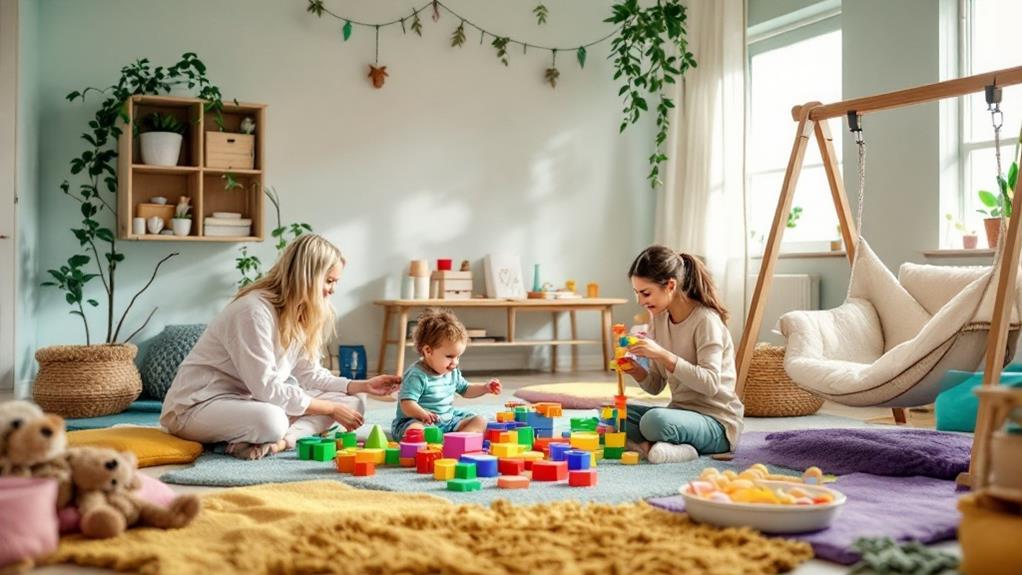In Central Iowa, you can find inspiring therapy options like Occupational Therapy (OT) and Applied Behavior Analysis (ABA) that focus on sensory integration. These services help children navigate their sensory worlds, fostering resilience and independence. OT promotes exploration through hands-on activities, while ABA uses positive reinforcement to encourage desired behaviors. Together, they create a holistic approach, addressing the unique challenges each child faces. In this supportive environment, children learn to thrive and connect with others. As you explore these transformative services, you'll uncover even more ways to help your child flourish and meet their potential.
Key Takeaways
- Occupational therapy (OT) develops individualized sensory integration plans, promoting exploration in safe environments for children with sensory processing challenges.
- Applied Behavior Analysis (ABA) utilizes positive reinforcement and data monitoring to encourage desired behaviors and skill acquisition in children.
- Integrative approaches combine OT and ABA, addressing underlying challenges to nurture emotional growth and resilience in children.
- Designing sensory-friendly spaces and incorporating movement activities help regulate sensory input and enhance children's coping skills.
- Community support and resources, including local workshops and support groups, empower families to navigate sensory processing challenges effectively.
Understanding Sensory Processing

Understanding sensory processing is fundamental for helping children thrive in their environments. Every child experiences the world uniquely, processing sensory information in ways that might differ from the norm. As you reflect on this, consider how a child's reactions to sights, sounds, textures, and smells shape their daily experiences. Some may feel overwhelmed by bright lights, while others might seek out physical sensations to feel grounded.
Recognizing these differences is the first step towards fostering an inclusive environment, where every child can flourish. You have the power to create spaces that accommodate their needs—spaces where they feel safe, understood, and empowered. As you learn about sensory processing, think about how you can support children in maneuvering their sensory experiences.
Empathy plays a significant role here. By tuning into their feelings and perspectives, you can help them express themselves more effectively. Remember, your goal isn't just to help them cope; it's to inspire them to embrace their individuality.
In doing so, you're not only enhancing their lives but also enriching your own understanding of the vibrant tapestry of childhood. Together, you can nurture resilience and joy in their sensory journeys.
The Role of Occupational Therapy
Occupational therapy serves as an essential bridge for children maneuvering the complexities of sensory processing. In your role as a caregiver or educator, you'll witness how OT professionals skillfully create individualized plans that empower children to engage with their environment. They focus on enhancing sensory integration, helping kids learn to process and respond to sensory inputs effectively.
Through hands-on activities and therapeutic play, occupational therapists encourage children to explore their senses in a safe and supportive space. You'll see children gain confidence as they learn to manage sensory overload or seek sensory experiences that help them feel grounded. It's about fostering resilience and independence, giving kids the tools to navigate daily challenges.
Moreover, the collaborative approach of occupational therapy involves working closely with families, schools, and other professionals. You'll find that this partnership not only enriches the child's experience but also builds a community of support around them.
Insights Into Applied Behavior Analysis

While occupational therapy lays a strong foundation for sensory integration, Applied Behavior Analysis (ABA) offers valuable insights into how children can learn to navigate their environments through behavior modification techniques.
By understanding the principles of ABA, you can empower children to develop essential skills and improve their interactions with the world around them.
Here are some key insights from ABA that can enhance your approach:
- Positive Reinforcement: Encourage desired behaviors by rewarding them, helping children feel motivated and successful.
- Data-Driven Decisions: Monitor progress through precise data collection, enabling informed adjustments to strategies.
- Functional Behavior Assessment: Identify the reasons behind behaviors, allowing for targeted and effective interventions.
- Skill Acquisition: Break down complex tasks into manageable steps, making learning more achievable and less overwhelming.
- Generalization: Teach skills in various settings, ensuring children can apply what they've learned in real-life situations.
Benefits of Integrative Approaches
Integrative approaches in therapy create a powerful synergy, blending various methodologies to support children's unique sensory processing needs. By combining Occupational Therapy (OT) and Applied Behavior Analysis (ABA), you foster a thorough environment where each child's strengths shine through. This holistic perspective addresses not just the symptoms but the underlying challenges, promoting lasting change.
When you embrace integrative strategies, you're not just treating behaviors; you're nurturing emotional growth and resilience. Children learn to navigate their sensory experiences with confidence, gaining essential skills that extend beyond therapy sessions. You empower them to express themselves effectively, helping to strengthen their communication and social interactions.
Additionally, this collaborative approach encourages family involvement, bringing parents and caregivers into the therapeutic process. You create a unified support system that helps children feel understood and valued, laying the foundation for a brighter future.
In serving others, you witness the incredible transformations that occur when various therapeutic disciplines unite. Each child becomes a reflection of the power of integrative approaches, thriving in an environment that truly understands and addresses their sensory processing needs.
Together, you can inspire hope and foster meaningful change in their lives.
Strategies for Sensory Integration

Finding effective strategies for sensory integration can transform a child's therapeutic journey. You can make a significant impact by incorporating these approaches into your practice or home environment. Each child is unique, so it's important to tailor strategies to their individual needs.
Here are some ideas to help you get started:
- Create a sensory-friendly space: Designate a calming area with soft lighting, textures, and quiet activities.
- Use sensory bins: Fill containers with rice, beans, or sand for tactile exploration that encourages fine motor skills.
- Incorporate movement activities: Activities like swinging, jumping, or dancing can help regulate sensory input.
- Introduce calming techniques: Teach deep breathing, mindfulness, or yoga to help children manage overwhelming sensations.
- Foster social interaction: Encourage group activities that promote teamwork and communication, helping children learn to navigate social cues.
Success Stories From Central Iowa
Success stories from Central Iowa highlight the transformative power of tailored sensory processing strategies in therapy for children. Families have witnessed remarkable changes as their loved ones engage in occupational therapy (OT) and applied behavior analysis (ABA) services.
One parent recalls how their son, once overwhelmed by loud noises and bright lights, has learned to self-regulate and now enjoys community events without distress. This progress not only uplifts the child but strengthens family bonds, fostering shared experiences and joy.
Another inspiring tale comes from a young girl who struggled with fine motor skills. Through personalized OT sessions, she developed confidence and now excels in art projects at school, expressing herself creatively. Her journey reminds us that every small victory builds toward greater achievements.
These stories resonate deeply, reflecting the resilience of children and the unwavering support from dedicated therapists and families. They remind us that with the right strategies, compassion, and commitment, we can help children thrive.
Embracing these successes encourages us to continue our mission of making a difference in the lives of children in Central Iowa and beyond. Together, we can inspire hope and positivity in the community.
Resources for Families

Maneuvering the world of sensory processing can feel overwhelming for families, but there are valuable resources available to help you and your child thrive.
It's important to know you're not alone, and many organizations are dedicated to supporting families through this journey.
Here are some resources you can explore:
- Local Support Groups: Connect with other families facing similar challenges and share experiences.
- Online Communities: Join forums and social media groups focused on sensory processing to gain insights and advice.
- Educational Workshops: Attend workshops offered by therapists in your area to learn about sensory integration strategies.
- Books and Guides: Explore literature on sensory processing to better understand your child's needs and how to address them.
- Therapist Directories: Use resources like the American Occupational Therapy Association or local ABA providers to find specialized therapists.
These resources can empower you with knowledge, support, and community.
Remember, every step you take towards understanding sensory processing is a step toward helping your child thrive.
You're building a brighter future, not just for your child, but for your entire family.
Conclusion
In Central Iowa, the journey of sensory processing isn't just a challenge; it's an opportunity for growth. By combining occupational therapy and applied behavior analysis, you're not just helping children navigate their worlds—you're truly setting them up for success. Remember, every small step can lead to big changes. With the right strategies and support, you can empower your child to thrive, turning obstacles into stepping stones on their path to a brighter future.
